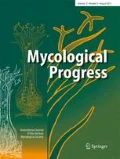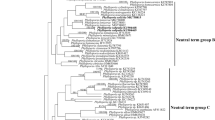Abstract
Morphological and molecular discrepancies in the biodiversity of monophyletic groups are challenging. The intention of this study was to find out whether the high molecular diversity in Sebacinales can be verified by micromorphological characteristics. Therefore, we carried out molecular and morphological studies on all generic type species of Sebacinales and additional representative taxa. Our results encouraged us to disentangle some phylogenetic and taxonomic discrepancies and to improve sebacinalean classifications. This comprises generic circumscriptions and affiliations, as well as higher taxon groupings. At the family level, we redefined the Sebacinaceae, formerly the Sebacinales group A, and set it apart from the Sebacinales group B. For taxonomical purposes, it seems appropriate to refer Paulisebacina, Craterocolla, Chaetospermum, Globulisebacina, Tremelloscypha, and Sebacina to the Sebacinaceae and Piriformospora, and Serendipita to the Sebacinales group B. At the lower taxonomic level, we propose within the Sebacinaceae (1) to introduce Paulisebacina for Sebacina allantoidea, (2) to transfer Efibulobasidium rolleyi into a new monotypic genus, Globulisebacina, (3) to include Tremellostereum in Tremelloscypha, (4) to transfer Sebacina amesii into Tremelloscypha, (5) to combine S. helvelloides and S. concrescens in their own genus, Helvellosebacina, (6) to transfer Tremellodendron spp. into Sebacina, (7) to define S. epigaea s.str. without cystidia and flagelliform dikaryophyses, but with star-shaped resting spores, and (8) to separate S. cystidiata with simultaneously irregular germinating spores and inconspicuous cystidia, and S. flagelliformis with flagelliform dikaryophyses from S. epigaea s.str. Additional clades in Sebacina, based on molecular differences, cannot be distinguished morphologically at present.





















Similar content being viewed by others
References
Bandala VM, Montoya L, Villegas R (2011) Tremelloscypha gelatinosa (Sebacinales) from tropical deciduous Gymnopodium forests in southern Mexico. Mycotaxon 118:147–157
Basiewicz M, Weiß M, Kogel K-H, Langen G, Zorn H, Zuccaro A (2012) Molecular and phenotypic characterization of Sebacina vermifera strains associated with orchids, and the description of Piriformospora williamsii sp. nov. Fungal Biol 116:204–213
Berkley MJ (1856) Decades LIX – LX. Rio Negro fungi. Hooker’s Jour Bot 8:233–241
Berkley MJ, Broome CE (1848) Notices of British fungi. Ann Mag Nat Hist 2:259–268
Bodman MC (1942) The genus Tremellodendron. Am Midland Nat 27:203–216
Bourdot H, Galzin A (1927) Hyménomycètes de France, Hetérobasidiés – Homobasidiés gymnocarpes. Sceaux
Brefeld O (1888) Untersuchungen aus dem Gesammtgebiete der Mykologie 7:99
Burt EA (1915) The Thelephoraceae of North America V. Tremellodendron, Eichleriella, and Sebacina. Ann Mo Bot Gard 2:731–771
Corner EJH (1968) A monograph of Thelephora. Beih Nova Hedwigia 27:1–110
De Fonseka RN (1960) The morphology of Chaetospermum chaetosporum. Trans Brit Mycol Soc 43:631–636
Donk MA (1958) The generic names proposed for Hymenomycetes – VIII. Auriculariaceae, Septobasidiaceae, Tremellaceae, Dacrymycetaceae. Taxon 7:164–178, 193–207, 236–250
Garnica S, Riess K, Bauer R, Oberwinkler F, Weiß M (2013) Phylogenetic diversity and structure of sebacinoid fungi associated with plant communities along an altitudinal gradient. FEMS Microbiol Ecol 83:265–278
Garnica S, Riess K, Schön ME, Oberwinkler F, Setaro S (2014) Divergence times, nutrition modes and lineage diversifications in the evolution of Sebacinales (in prep.)
Glen M, Tommerup IC, Bougher NL, O Brien PA (2002) Are Sebacinaceae common and widespread ectomycorrhizal associates of Eucalyptus species in Australian forests? Mycorrhiza 12:243–247
Hauerslev K (1993) New tremellaceous fungi from Denmark. Mycotaxon 49:217–233
Henkel TW, Roberts P, Aime MC (2004) Sebacinoid species from the Pakaraima mountains of Guyana. Mycotaxon 89:433–439
Henkel TW, Aime MC, Chin MML, Miller ST, Vilgalys R, Smith ME (2011) Ectomycorrhizal fungal sporocarp diversity and discovery of new taxa in Dicymbe monodominant forests of the Guiana shield. Biodivers Conserv 21:2195–2220
Katoh K, Kuma K, Toh H, Miyata T (2005) MAFFT version 5: improvement in accuracy of multiple sequence alignment. Nucleic Acids Res 33:511–518
Kirschner R, Oberwinkler F (2002) Sebacina allantoidea sp. nov. Cryptogam Mycol 23:129–133
Kirschner R, Oberwinkler F (2009) Supplementary notes on Basidiopycnis hyalina (Basidiomycota, Atractiellales) and its anamorph. Mycotaxon 109:29–38
Lloyd CG (1916) Mycological Notes No. 42. Mycol Writ 5:576–588
Lloyd CG (1922) Mycological Notes No. 67. Mycol Writ 7:1137–1168
Maddison WP, Maddison DR (2011) Mesquite: a modular system for evolutionary analysis. Version 2.75. Available from http://mesquiteproject.org/
McKendrick SL, Leake JR, Taylor DL, Read DJ (2002) Symbiotic germination and development of the myco-heterotrophic orchid Neottia nidus-avis in nature and its requirement for locally distributed Sebacina spp. New Phytol 154:233–247
Mühlmann O, Peintner U (2008) Ectomycorrhiza of Kobresia myosuroides at a primary successional glacier forefront. Mycorrhiza 18:355–362
Nag Raj TR (1993) Coelomycetous anamorphs with appendage-bearing conidia. Mycol Publ, Waterloo, Ontario, Canada, 1101 pp
Oberwinkler F (1963) Niedere Basidiomyceten aus Südbayern III. Die Gattung Sebacina Tul. s. 1. Ber Bayer Bot Ges 36:41–55
Oberwinkler F (1964) Intrahymeniale Heterobasidiomyceten. Fruchtkörperlose Sebacina-Sippen und ihre systematische Stellung. Nova Hedw 7:483–499
Oberwinkler F, Riess K, Bauer R, Selosse M-A, Weiß M, Garnica S, Zuccaro A (2013) Enigmatic Sebacinales. Mycol Prog 12:1–27
Palmer JM, Lindner DL, Volk TJ (2008) Ectomycorrhizal characterization of an American chestnut (Castanea dentata)-dominated community in Western Wisconsin. Mycorrhiza 19:27–36
Patouillard MN (1888) Note sur une Tuberculariée graminicole. Bull Soc Mycol Fr 4:39–40
Persoon CH (1796) Observationes mycologicae seu descriptiones tam novorum, quam notabilium fungorum. Lipsiae, apud Petrum Phillippum Wolf
Rajeshkumar KC, Singh PN, Yadav LS, Swami SV, Singh SK (2010) Chaetospermum setosum sp. nov. from the Western Ghats, India. Mycotaxon 113:397–404
Reid DA (1979) Tremelloscypha and Papyrodiscus—two new genera of Basidiomycetes from Australia. Beih Sydowia Ann Myc Ser II 8:332–334
Riess K, Oberwinkler F, Bauer R, Garnica S (2013) High genetic diversity at the regional scale and possible speciation in Sebacina epigaea and S. incrustans. BMC Evol Biol 13:102. doi:10.1186/1471-2148-13-102
Riess K, Oberwinkler F, Bauer R, Garnica S (2014) Communities of endophytic Sebacinales associated with roots of herbaceous plants in agricultural and grassland ecosystems are dominated by Serendipita herbamans sp. nov. PLoS ONE 9(4):e94676. doi:10.1371/journal.pone.0094676
Rineau F (2008) Étude des conséquences du chaulage sur la structure et le fonctionnement des communautés d’ectomycorrhizes des forêts des Vosges. Thèse pour l’obtention du titre de docteur de l’Université Henri Poincaré, Nancy
Rineau F, Garbaye J (2009) Does forest liming impact the enzymatic profiles of ectomycorrhizal communities through specialized fungal symbionts? Mycorrhiza 19:493–500
Roberts P (1993) Exidiopsis species from Devon, including the new segregate genera Ceratosebacina, Endoperplexa, Microsebacina, and Serendipita. Mycol Res 97:467–478
Rungjindamai N, Skayaroj J, Plaingam N, Somrithipol S, Jones EBG (2008) Putative basidiomycete teleomorphs and phylogenetic placement of the coelomycete genera: Chaetospermum, Giulia and Mycotribulus based on nu-rDNA sequences. Mycol Res 112:802–810
Ryvarden L (1986) Tremellostereum (Tremellaceae) nov. gen. Mycotaxon 27:321–323
Saccardo PA (1892) Sylloge Fungorum 10, Padua
Selosse M-A, Setaro S, Glatard F, Richard F, Urcelay C, Weiß M (2007) Sebacinales are common mycorrhizal associates of Ericaceae. New Phytol 174:864–878
Selosse M-A, Dubois M-P, Alvarez N (2009) Do Sebacinales commonly associate with plant roots as endophytes? Mycol Res 113:1062–1069
Setaro S, Weiß M, Oberwinkler F, Kottke I (2006) Sebacinales form ectendomycorrhizae with Cavendishia nobilis, a member of the Andean clade of Ericaceae, in the mountain rain forest of southern Ecuador. New Phytol 169:355–365
Tedersoo L, Smith ME (2013) Lineages of ectomycorrhizal fungi revisited: foraging strategies and novel lineages revealed by sequences from belowground. Fungal Biol Rev 27:83–89
Tedersoo L, Suvi T, Larsson E, Kõljalg U (2006) Diversity and community structure of ectomycorrhizal fungi in a wooded meadow. Mycol Res 110:734–748
Tedersoo L, Abarenkov K, Nilsson RH, Schüssler A, Grelet G-A, Kohout P, Oja J, Bonito GM, Vledre V, Jairus T, Ryberg M, Larsson KH, Kõljalg U (2011) Tidying up international sequence databases: ecological, geographical and sequence quality annotation of ITS sequences of mycorrhizal fungi. PLoS ONE 6(69):e24940. doi:10.1371/journal.pone.0024940
Tedersoo L, Arnold E, Hansen K (2013) Novel aspects in the life cycle and biotrphic interactions in Pezizomycetes (Ascomycota, Fungi). Mol Ecol 22:1488–1493
Tulasne LRE, Tulasne C (1872) Fungi Tremellini et leurs alliés. Ann Sci Nat Bot 15:225–226
Urban A, Weiß M, Bauer R (2003) Ectomycorrhizae involving sebacinoid mycobionts. Mycol Res 107:3–14
Verma S, Varma A, Rexer K-H, Hassel A, Kost G, Sarbhoy A, Bisen P, Bütehorn B, Franken P (1998) Piriformospora indica, gen. et sp. nov., a new root-colonizing fungus. Mycologia 90:896–903
Walker JF, Parrent JL (2004) Molecular phylogenetic evidence for the mycorrhizal status of Tremellodendron (Sebacinaceae). Mem N Y Bot Gard 89:291–296
Warcup JH (1971) Specificity of mycorrhizal association in some Australian terrestrial orchids. New Phytol 70:41–46
Warcup JH (1981) The mycorrhizal relationships of Australian orchids. New Phytol 87:371–381
Warcup JH (1988) Mycorrhizal associations of isolates of Sebacina vermifera. New Phytol 110:227–231
Warcup JH, Talbot PHB (1967) Perfect states of Rhizoctonias associated with orchids I. New Phytol 66:631–641
Weiß M, Oberwinkler F (2001) Phylogenetic relationships in Auriculariales and related groups—hypotheses derived from nuclear ribosomal DNA sequences. Mycol Res 105:403–415
Weiß M, Selosse M-A, Rexer K, Urban A, Oberwinkler F (2004) Sebacinales: a hitherto overlooked cosm of heterobasidiomycetes with a broad mycorhizal potential. Mycol Res 108:1003–1010
Weiß M, Garnica S, Bauer R, Oberwinkler F (2010) Serendipitaceae, a new family in the Sebacinales. Poster IMC IX, Edinburgh
Weiß M, Sykorová Z, Garnica S, Riess K, Martos F, Krause C, Oberwinkler F, Bauer R, Redecker D (2011) Sebacinales everywhere: previously overlooked ubiquitous fungal endophytes. PLoS ONE 6(2):e16793. doi:10.1371/journal.pone.0016793
Weiß M, Garnica S, Bauer R, Oberwinkler F (2012) Serendipitaceae, a new family in the Sebacinales. Poster Ann Meeting German Phytopath Soc
Wells K (1975) Studies of some Tremellaceae. V. A new genus, Efibulobasidium. Mycologia 67:147–156
Wells K, Bandoni RJ (2001) Heterobasidiomycetes. In: McLaughlin, DJ, EG McLaughlin, and PA Lemke (eds.): The Mycota VII Part B, pp. 85–120
Wells K, Oberwinkler F (1982) Tremelloscypha gelatinosa, a species of a new family Sebacinaceae. Mycologia 74:325–331
Acknowledgements
This study was supported by a research grant, OB 24/30-1, of the German Research Council (DFG). We are very grateful to R. Kirschner for a critical pre-review of the manuscript and helpful comments, and to V. Bandala, L. Ryvarden, S. Setaro, and L. Tedersoo for providing fungal material. Laboratory assistance of S. Silberhorn is gratefully acknowledged.
Author Contributions
FO, KR, and SG collected fungal samples, FO performed the microscopic work and illustrations, and wrote the paper. KR and SG conceived and designed the molecular studies, and constructed the phylogenetic tree. RB added critical comments.
Author information
Authors and Affiliations
Corresponding author
Electronic supplementary material
Below is the link to the electronic supplementary material.
Supplementary File 1
(DOCX 107 kb)
Supplementary File 2
(DOCX 143 kb)
Supplementary File 3
(XLS 77.5 kb)
Supplementary File 4
(PDF 443 kb)
Rights and permissions
About this article
Cite this article
Oberwinkler, F., Riess, K., Bauer, R. et al. Morphology and molecules: the Sebacinales, a case study. Mycol Progress 13, 445–470 (2014). https://doi.org/10.1007/s11557-014-0983-1
Received:
Accepted:
Published:
Issue Date:
DOI: https://doi.org/10.1007/s11557-014-0983-1




